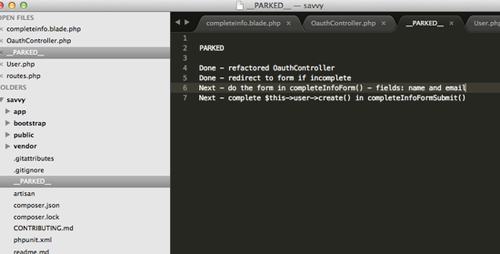[This post originally appeared on the Savvy Blog]
Anyone who has worked on a large enough project would have encountered this:
Every day, before starting work, we spend a good few minutes (sometimes up to 30 minutes) just getting our "brain into gear" and re-familiarising ourself with where we left off the day before.
If you're a coder like me, you may have your dev environment already open from the day before, giving you clues to where you left off. You may also look at your repository log to read your last commit to find out where you were.
And then you pick up the next task, and start working on it. If the next item is a small task, you get on with it. If it's a larger task, you would spend a bit more time on the context of the problem... a bit of thinking time, which feels a bit heavy first thing in the morning.
Parking downhill
But here's a tip I picked up which has worked like magic for me, getting my brain into gear before my second sip of cappuccino in the morning. It's called "parking downhill" and the clue is in an earlier sentence above:
"If the next item is a small task, you get on with it".
The idea is to systematically give yourself a short list of "small tasks", or "pickup tasks", for you to do at the start of the next day. These are tasks that won't need much thought to complete. Like "Make page title bold" or "Order customer list alphabetically".
This way, we start the day by being productive straight away, with tasks that are simple, but help us "warm up" towards bigger tasks that require more thought.
The technique
So here's what you do...
Step 1. Create your pickup tasks
Before finishing for the day, or when you know there'll be a significant pause on the work before you continue with it, identify the next set of simple tasks that you need to do. These will form your "pickup tasks" for the next day.
Step 2. Note them down
Make a note of these "pickup tasks" somewhere easily accessible. I recommend that this "somewhere" be the one single place you refer to all the time for your pickup tasks, so that you won't forget it.
Remember that the whole point of this is to minimise having to think too much right at the start of your day, and get stuck in quick. I always have a text file called __PARKED__ at the root of all my project folders, one file per project.

Step 3. Turn your computer off
And you know that when you come back to your project, you're ready to lift the handbrake, roll down the hill, and get into cruising speed effortlessly.
Bonus side effect: this technique gave me one happy side effect: I found myself ticking off tasks quickly, contributing to a real sense of achievement very early on in the day. That feeds into my motivation levels and keeps the momentum high.
Beyond coding
I actually picked this tip up while I was writing my dissertation at university, from an excellent book titled Writing Your Dissertation in Fifteen Minutes a Day: A Guide to Starting, Revising, and Finishing Your Doctoral Thesis.

Author Joan Bolker lists various productivity techniques to help dissertation writers but I think a lot of what is written can be useful for any sort of knowledge work. The original phrase "parking on the downhill slope" is mentioned in this book (read the excerpt).
Hope you give it a go. Would love to hear whether it works for you too in the comment below!